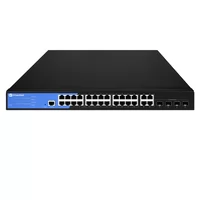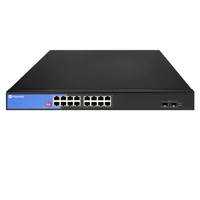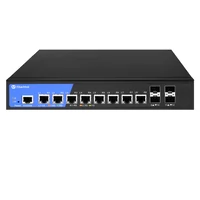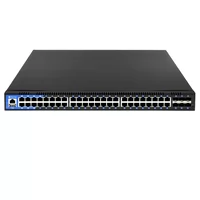Given the reality of the modern world, choosing a network switch is one of the first and foremost steps for creating a functional and effective network infrastructure. All home offices, businesses, and big corporations utilize a specific type of switch. Your decision regarding the type of switch to employ will ultimately dictate the network’s performance, scalability, and security. There are many options on the market today, from unmanaged to fully managed switches, and understanding the most important considerations and features is paramount. This guide will simplify the procedure, providing you with the most crucial elements to pay attention to and assisting you in identifying which network switch is the most appropriate for your requirements.
What Should You Consider in a Network Switch?

The following considerations are essential when choosing a network switch:
- Port Count and Speed: Confirm the port limitations along with the construction speed of the switches (for example, Gigabit Ethernet switches) to see if they meet the network requirements.
- Managed vs. Unmanaged: Complex networks or organizations are best managed with Managed Switches that give VLANs, traffic control, and monitoring features. On the other hand, unmanaged switches are more suited for basic configurations.
- PoE (Power over Ethernet): Eliminates the use of power outlets for devices like IP cameras and wireless access points, which can be accomplished using a PoE-capable switch.
- Scalability: Unmanaged network switches tend to neglect future scalability; therefore, a switch that balances the increase in demand over time is selected.
- Reliability and Security: Special features like redundancy can give a strong and secure network operation with suitable hardware for the switch.
Considering the above will enable you to switch to the network that best matches your present and forthcoming requirements.
Understanding Network Switch Types: Managed vs. Unmanaged
The primary distinction between managed and unmanaged network switches lies in the latter’s functional features and control options. An unmanaged switch is plug-and-play, requiring no setup or configuration, and is perfect for essential networks and setups with low control requirements. It offers limited functionality in terms of connectivity options, allowing these types of switches to come at a lower cost and be devoid of features like performance monitoring and traffic management.
On the other hand, managed switches permit a higher level of control and fine-tuning options such as VLAN configurations, traffic prioritization, and even network performance monitoring. Due to their high-performance requirements, these devices are ideal for complex or even expansive networks that need uncompromised reliability, security, and scalability. While such switches cost more and have a steep learning curve due to their complex setup, growing or technically advanced networks benefit greatly from their configuration options.
The Importance of the Number of Ports
The number of ports on a network switch is important as it dictates how many devices can connect to the network. Smaller setups may require fewer ports, such as 8 or 12, while larger environments often need switches with 24, 48, or more. While deciding the number of ports, make sure to address the current network problem and potential future growth to ensure scalability. A limited number of ports can obstruct connectivity, costs can be incurred with too many ports, and ultimately sink port efficiency. When striving for an organization’s efficiency and avoiding resource constraints, determining the precise requirements of the network cable ensures resolving this problem.
Evaluating Switch Features and Scalability
Evaluating switch features based on compatibility, performance, and security is best. Ensure the switch has the required network speed (1 Gbps or 10 Gbps) and that hardware support is needed. Features like VLAN, QoS, and PoE should be strongly considered if applicable to network needs. Scalability is crucial, so select modular, stackable switches, or both so complete replacements aren’t needed down the line. Always start with reputable vendors known for dependable tech support and firmware upgrades for sustained network performance and security.
Why is Port Count Important in a Network Switch?

Determining the Ideal Number of Ports for Home and Office Networks
The ideal switch ports for a network switch will depend on the number of devices in use and possible future growth. While a home network may be served with 4 to 8 ports to connect computers, smart TVs, and gaming consoles, office networks that involve multiple workstations, printers, copiers, and other peripherals may require a 24-port or larger switch. The number of ports on the switch must always serve present requirements, but there should be enough to permit growth with more users to reduce the potential for frequent changes or upgrades.
The Role of Ethernet Ports in Network Performance
Wired network functionality relies heavily on Ethernet ports; their importance in speed, stability, and reliability cannot be overstated. Unlike wireless connections, Ethernet ports link devices to the network, which enables lower latency and constant data transfer rates. The specifications of Ethernet ports, such as speed ratings (Fast Ethernet at 100 Mbps, Gigabit Ethernet at 1 Gbps, or 10 Gigabit Ethernet), have a bearing on their performance. For office environments or homes with numerous high-bandwidth devices, faster Ethernet ports are essential because gigabit speeds significantly improve performance. Network performance can be enhanced dramatically by changing outdated Ethernet ports for sufficient speed.
How Does Ethernet Technology Affect Network Performance?

Advantages of Gigabit Ethernet Over Fast Ethernet
The data transfer rate of 1 Gbps on Gigabit Ethernet surpasses the 100 Mbps offered with Fast Ethernet, making it ideal for contemporary usage that requires greater bandwidth. The increase in speed alleviates the bottleneck issues associated with data-intensive activities, including but not limited to video streaming, transferring large files, and using cloud services. Moreover, Gigabit Ethernet aids in improving network performance and scaling, which eases the functionality in multi-device environments. The improved efficiency in handling higher traffic volumes ensures enhanced network performance and reliability for business and residential settings, eliminating the possibility of poor network service.
Exploring Power Over Ethernet (PoE) Capabilities
Power over Ethernet (PoE) is a technology that integrates data transmission and electrical power transfer in one Ethernet cable, facilitating the installation of devices and eliminating the requirement for separate power sources. This is especially useful for powering IP cameras, wireless access points, and VoIP phones. PoE works within set parameters, like the IEEE 802.3 af and IEEE 802.3at standards, guaranteeing compatibility and safety. With no restriction to electricity-powered interfaces, PoE supports deploying devices in any location, significantly increasing flexibility and cost-effectiveness in the network infrastructure, especially in the case of unmanaged network switches.
How to Monitor Your Network with Switches?

Tools for Effective Network Management
Switches are vital to control and maintain oversight over devices within a network, which necessitates adequate supervision and control of the whole network. Managed switches allow for traffic monitoring, VLAN configuration, and port mirroring, which assist the administrator in managing the network and troubleshooting its problems. Managed switches can be integrated with SNMP(Simple Network Management Protocol) software tools and can fetch information related to device health, bandwidth consumption, or reported errors in the network. Putting up dashboards with real-time analytics also makes monitoring the network and finding problem areas more manageable. With these tools, the network works optimally and reliably, reducing the chance of failure and downtime.
Using Smart Switches to Monitor Network Traffic
The easy-to-use features and essential management capabilities make smart switches a cost-effective solution for monitoring network traffic. Smart switches empower administrators to manage data flow and prioritize critical applications by enabling basic traffic monitoring and configuring Quality of Service (QoS) and VLANs. These devices often come with easy-to-use web interfaces that simplify the setup and management of small- to medium-sized networks. Despite the absence of advanced features available with fully managed switches, smart switches provide sufficient control for effective network performance monitoring and optimization in simpler environments.
What High-Speed Switch Options Are Available?

Exploring Gigabit Switch Options for Fast Connectivity
Modern networks can benefit from the connectivity provided by gigabit switches with unparalleled 1 Gbps data transfer speeds. These switches are perfect for high-bandwidth use cases like video streaming, file sharing, and VoIP calls. Gigabit switches come in both tagged and unmanaged varieties. Unmanaged switches have no configuration options and are completely plug-and-play, while tagged switches enable more complex features like traffic management, security, and network segmentation. This level of customization offers greater flexibility to sophisticated deployments. Cisco, Netgear, and TP-Link are reputable manufacturers who understand different network sizes and configurations, so they offer a massive collection of Gigabit switches.
Understanding the Benefits of Layer 3 Switches
Layer 3 switches are the most versatile in networking because they combine the functions of basic switches and routers. One of their most significant advantages is that routing is done as hardware processing instead of software, improving network performance and speed. Layer 3 switches are particularly effective on larger networks that experience a higher data volume, such as in an enterprise environment needing seamless inter-VLAN routing.
Enhanced security is one of the benefits of Layer 3 switches, with their ability to support multiple Virtual Local Area Networks (VLANs) and aid in IP routing while enabling the reduction of broadcast traffic for better network performance. These units also support advanced functionalities like Quality of Service (QoS), ensuring time-sensitive operations like VoIP or video conferencing can be executed without delays.
In addition, Layer 3 switches tend to come with improved scalability and management functionality. They usually enable the use of OSPF (Open Shortest Path First) and BGP (Border Gateway Protocol), which facilitate intricate network structures and effective utilization of routes in changing surroundings. Many well-known models, including those from Juniper Networks and Cisco, include backup power feed units and sophisticated monitoring features that provide great dependability and uptime. As a result, Layer 3 switches are ideal for companies looking for scalable, security-oriented, and high-performance networking solutions.
The Value of High-Speed Ethernet Switches in Growing Networks
The efficiency provided by high-speed ethernet switches makes them essential devices for any growing network as they ensure reliability, scalability, and necessary bandwidth support for increased traffic demands. They allow different devices in a network to transfer data at high speeds, which lowers latency while reducing network bottlenecks, ensuring seamless connectivity. Alongside these features, these switches support port aggregation and VLANs, improving efficiency and organization in the network. Well-known manufacturers such as Cisco and Juniper have models tailored for high throughput to enable constant business operations, making them a critical component for expanding business operations and guaranteeing growth of the network infrastructure.
Frequently Asked Questions (FAQs)
Q: What is a network switch, and why is it essential for your network infrastructure?
A: A network switch is a device that connects multiple devices on the network, allowing them to communicate efficiently. Network switches are necessary for traffic management and provide maximum performance in a home network and an SOHO (small office, home office) environment.
Q: How do I choose the best network switch for my needs?
A: To determine the best switch for your network, consider the number of devices you’d want to connect to it, whether managed and unmanaged switches are needed, and whether PoE support is necessary. If you’re budget-conscious, consider specifics like QoS, VLAN, and bandwidth support, especially when utilizing series switches for enhanced performance.
Q: What is the difference between a managed switch and an unmanaged switch?
A: An unmanaged switch is frequently described as a plug-and-play device that requires no configuration. It is ideal for consumers with basic connectivity requirements. On the other hand, a managed switch has advanced features, including VLAN support, QoS, and traffic management, making it suitable for more complex network setups.
Q: What factors should I consider to determine the port count for my network switch?
A: When deciding on a switch’s port count, consider both the current devices you intend to connect and any potential future connections. Switches are usually designed to handle the required capacity for network devices. For future network growth, it is better to purchase a switch with more excellent ports than is currently necessary.
Q: What is the importance of PoE power to my network?
A: Devices such as IP cameras and wireless access points can be powered through the PoE (Power over Ethernet) technology, which allows network cables to transfer data and supply power. Switches meant for PoE enable more manageable and less expensive device installations because of the reduced need for cabling.
Q: Are there any known recommended brands for network switches?
A: TP-Link and Netgear provide other home and small office switches. These two companies are known for their wider availability and use of other network solutions.
Q: Would I be better served investing in gigabit ports or higher speeds, such as 2.5 GbE for my network switch?
A: For most home and small office networks, gigabit ports are more than sufficient and their data transfer rates are pretty efficient. However, if you have high bandwidth requirements or want to ensure that your networks meet future needs, switches with 2.5 GbE switch capabilities can be considered and are guaranteed to perform better.
Q: What are rackmount switches, and when should I use them?
A: Rackmount switches usually provide neat cable management for larger network structures. They are ideal when you need a high port density and are trying to consolidate network management in a server room or data center, especially with gigabit-enabled switches.
Q: What features do managed switches include that might benefit a small office?
A: Managed network switches also include VLAN support for segmenting different types of network traffic, QoS to give bandwidth to important applications, more security features, and many other functions that enable them to perform better and offer more control within a small office environment.
Q: Can small network setups utilize desktop switches?
A: Indeed, desktop switches’ small footprint and ease of implementation make them ideal for homes or small offices with limited space and rudimentary network configuration. They generally provide plug-and-play capabilities, which makes installation easier.
Reference Sources
1. Preemptive Switch Memory Usage to Accelerate Training Jobs with Shared In-Network Aggregation
- Authors: Hao Wang et al.
- Published: 2023
- Summary: This study presents a new Efficient Data-Plane switch memory Scheduler for in-network Aggregation (INA), DSA. It categorizes system-wide and intra-datacenter resource sharing as problematic, especially for Distributed Training (DT) workloads. DSA implements preemption for high-priority gradient tensors over lower-priority tensors, leading to better utilization of switch memory and less waiting time. Experimental results showed that DSA outperformed baseline solutions by improving average Job Completion Time (JCT) by 1.35 times.
- Methodology: The authors design a prototype of DSA and run it against benchmarked solutions, measuring job output and optimal usage of RAM during the processes (Wang et al., 2023, pp. 1-12).
2. A Generic Service to Provide In-Network Aggregation for Key-Value Streams
- Authors: Yongchao He et al.
- Published: 2023
- Summary: Developing ASK, an accelerated key-value stream aggregation system that is switch-host co-designed, is the focus of this paper. Specifically, ASK re-engineers traffic patterns with hardware constraints and achieves positive results. The assessment indicates that ASK can boost pure key-value aggregation activities three times and big data jobs between 3 and 5 times, all while remaining compatible with existing INA technologies.
- Methodology: The authors prototype ASK and evaluate its performance in different scenarios, demonstrating its effectiveness in improving aggregation tasks (He et al., 2023).
3. NetCache: Optimizing Key-Value Stores Through In-Network Caching
- Authors: Xin Jin et al.
- Published: 2017
- Summary: The paper proposes the NetCache architecture, which allocates the processing of frequently accessed items to programmable switches. This significantly improves load balancing among storage nodes. Results show a 3–10 times increase in throughput alongside lowered latency for a substantial portion of queries.
- Methodology: A prototype was developed on Barefoot Tofino switches and commodity servers to showcase the architecture’s effectiveness in achieving billions of queries per second (Jin et al., 2017).
Related Products:
-
 S2100-24T4TS, 24-Port Ethernet Switch L2+, 24x 10/100/1000BASE-T RJ45, with 4x 1G RJ45/SFP Combo Uplinks
$148.00
S2100-24T4TS, 24-Port Ethernet Switch L2+, 24x 10/100/1000BASE-T RJ45, with 4x 1G RJ45/SFP Combo Uplinks
$148.00
-
 S2100-16T2S-P, 16-Port Ethernet Switch L2+, PoE+ Switch, 16x 10/100/1000BASE-T RJ45, with 2x 1G SFP Uplinks
$230.00
S2100-16T2S-P, 16-Port Ethernet Switch L2+, PoE+ Switch, 16x 10/100/1000BASE-T RJ45, with 2x 1G SFP Uplinks
$230.00
-
 S3100-8T4X, 8-Port Ethernet Switch L3, 8x 10/100/1000/2500/10G BASE-T RJ45 Ports, with 4x 1G/10G SFP+ Uplinks
$398.00
S3100-8T4X, 8-Port Ethernet Switch L3, 8x 10/100/1000/2500/10G BASE-T RJ45 Ports, with 4x 1G/10G SFP+ Uplinks
$398.00
-
 S3100-48T6X-P, 48-Port Ethernet Switch L3, PoE+ Switch, 48x 10/100/1000BASE-T RJ45, with 6x 1G/10G SFP+ Uplinks
$734.00
S3100-48T6X-P, 48-Port Ethernet Switch L3, PoE+ Switch, 48x 10/100/1000BASE-T RJ45, with 6x 1G/10G SFP+ Uplinks
$734.00
